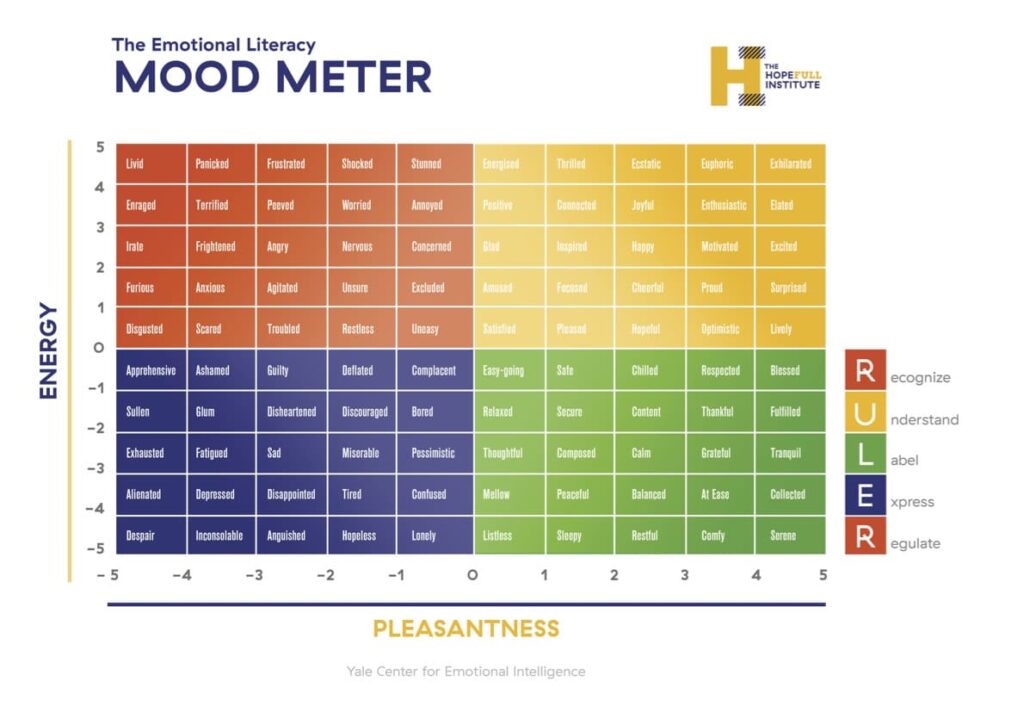Emotional intelligence is crucial for our mental and relational health.
Sometimes you worry that your mood changes at the drop of a hat. A family member asks you a question that catches you off guard, and you yell. Some time afterward, you realize that their question was pretty reasonable, and that the yelling may have been an overreaction. You start to add up all the times, even over the past week, in which you had a short fuse. You feel bad at how it impacts your relationships. Yet you know telling yourself to “stop it” only goes so far. What’s going on here?
Our ability to navigate relationships and reactions well involves a self-reflective skill called emotional intelligence. It’s the ability to notice what you’re feeling so you can manage it in a healthy way. Can you describe the difference between feeling:
- stressed vs. overwhelmed?
- frustrated vs. irritated?
- angry vs. disappointed?
In this blog, you’re going to learn how to pinpoint with accuracy what’s going on inside you at any given moment. By practicing this set of skills, you’ll be able to make better choices for yourself and relationships with others.
Here’s how to breakdown pinpointing your emotions.
RULER: An Acronym for Emotional Intelligence
Emotional Intelligence is a common term used to describe the awareness of one’s emotions. However, the way emotional intelligence is frequently discussed is often not the way it really is. According to emotions expert Dr. Marc Brackett, emotional intelligence is better understood as a set of skills. He uses the acronym RULER to describe these skills.
Understanding Emotions with RULER
R: Recognizing Feelings
The R in RULER stands for Recognizing emotions in oneself and others.
Have you ever tried reading someone’s facial expression as a clue to know they’re feelings about what you just said? What about providing an accurate answer to the question, “how’re you feeling today?” These are common scenarios in which recognizing emotions ourselves and in others become important to effective communication.
Start with the Energy and Pleasantness of How You Feel
In addition to RULER, Dr. Brackett shares the following tool called the Mood Meter from the Yale Center of Emotional Intelligence to help us differentiate emotions that may seem generally similar to one another.
Energy and Pleasantness
Can you locate the general sense of how high or low energy you feel right now? That’s often easier in the moment than recalling a nuanced emotion word, at first. How about the general sense of how pleasant or unpleasant you’re feeling? With the mood meter, you start with the general sensation of how you’re feeling and differentiate from there. For example, you may readily identify that you’re feeling lower energy and a moderate pleasantness. As a result, you’re able to determine with greater accuracy that you’re feeling relaxed in the moment.

U: Understanding Feelings
The U in RULER stands for Understanding the causes and consequences of emotions.
“Is this person interested in what I’m saying?” “Am I bored?” Once you’re able to recognize emotions in yourself and others, you’re next able to get curious about why someone feels the way they do. As a result, we can decide how to best connect to them in the present moment.
Differentiation Between Similar Feelings
One common conception about our emotions is that many emotion words are actually just describing the same generic feeling.
According to Dr. Brackett, when we’re able to differentiate between emotion states, then we’re able to pick a strategy that works best for that situation. For example, if you’re uncertain about the future, a breathing exercise may not help you. However, a cognitive strategy such as challenging a negative thought might be of assistance. On the other hand, if you’re actually overwhelmed, a breathing strategy such as box breathing may be the best strategy for the moment.

4 Commonly Confused Feelings
When we misdiagnose what we’re feeling, we’re unable to fully know the best strategy to cope with it. Here’s 4 common emotions commonly confused for the others.
Anxiety: Uncertainty about the future.
Stress: Distress from too many demands and not enough resources.
Overwhelm: Saturation with so much stimulus that you’re unsure of what’s happening.
Fear: The belief that someone or something is dangerous, painful, or threatening.
L: Labeling Feelings
The L in RULER stands for Labeling emotions using a nuanced vocabulary.
Describing our emotions using precise words. Consider the things that make you feel peeved versus irritated versus enraged. While everyone may feel emotions differently in their body, it’s important to have a rich vocabulary for the precise emotion we’re feeling. This is because without it, we can’t really communicate effectively about our specific experience. When there’s a common language of emotion within a community, we can communicate about these emotions in a way we can understand.
Granularity Within A Feeling
Just as distinguishing between two emotions helps us to determine what to do next, so does being able to distinguish between different shades of the same emotion category. Take for instance, anger. Are you outraged about a deep injustice? Or are you only mildly annoyed from someone changing lanes with no signal during traffic? Often times, knowing the degree to which we’re feeling an emotion can help us even better select what we choose to do with our emotions. When our behavior choices are disproportionate to the emotion felt, it may be time to get curious about why that is. We can learn how to make different choices based on the granularity of our anger, sadness, or fear.
Differentiation: Distinctions Between Emotions

Granularity: Nuance Within An Emotion

E: Expressing Feelings
The E in RULER stands for Expressing emotions in accordance with cultural norms and social context.
We have to know how we feel. This is because when we know how we feel, we can decide what we want to do with those feelings instead of letting them determine our behavior by default. Knowing how and when to express emotions with different people across contexts and culture provides us the opportunity to effectively communicate with the people around us. As a result, we more readily achieve the outcomes we want in our interactions with others. And, in effect, other people can more clearly and readily see us, hear us, and know us. A great first step to practicing expressing emotions is to share your feelings daily with trusted others using a nuanced set of emotion words.
R: Regulating Feelings
The final R in RULER stands for Regulating Emotions with helpful strategies.
Any emotion on average, visits for around 90 seconds. Consequently, this helps us to know we can effectively manage any emotion, no matter how overwhelming it can be. Once we’re open to expressing our emotions, using helpful strategies can help us ride the wave of our emotions instead of the wave riding us. Some of these helpful strategies can include specific acts of self compassion, self-soothing, positive distractions, and physical movement.
Start Growing Emotional Intelligence Today
I help people start recognizing, understanding, labeling, expressing, and regulating their emotions by providing guidance and support.

